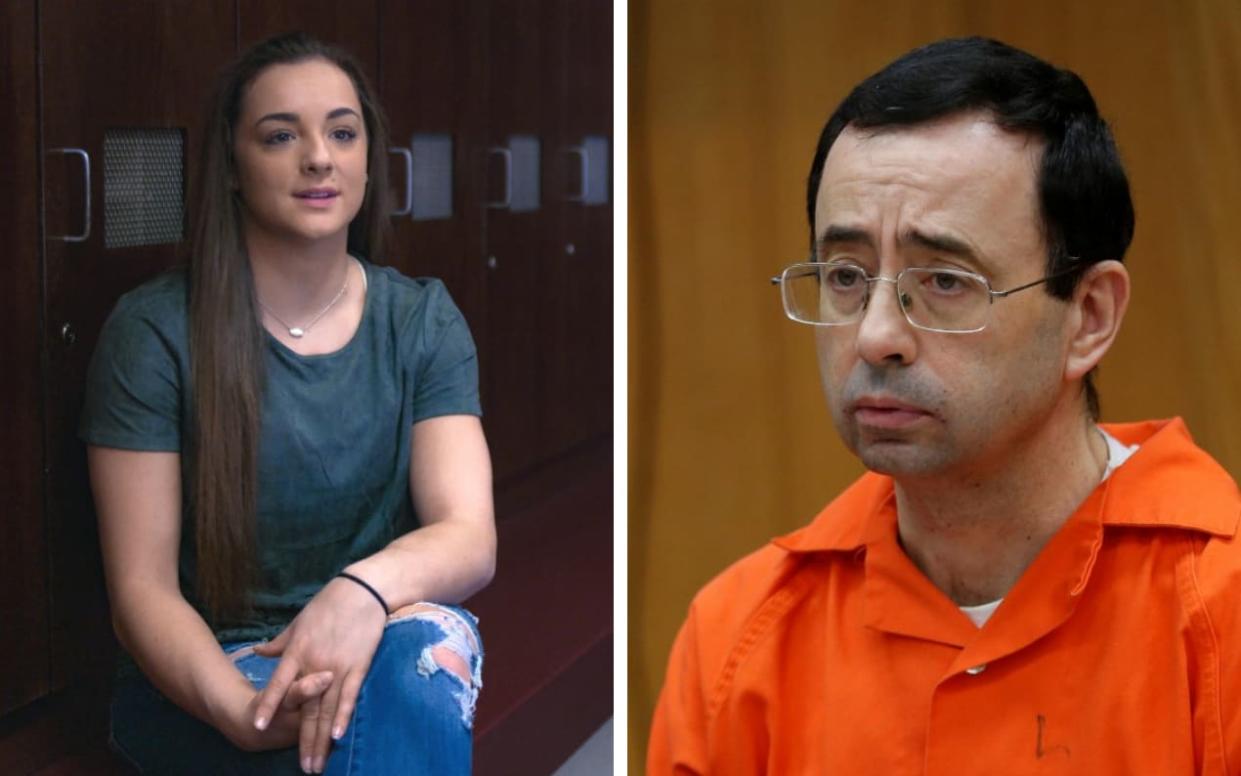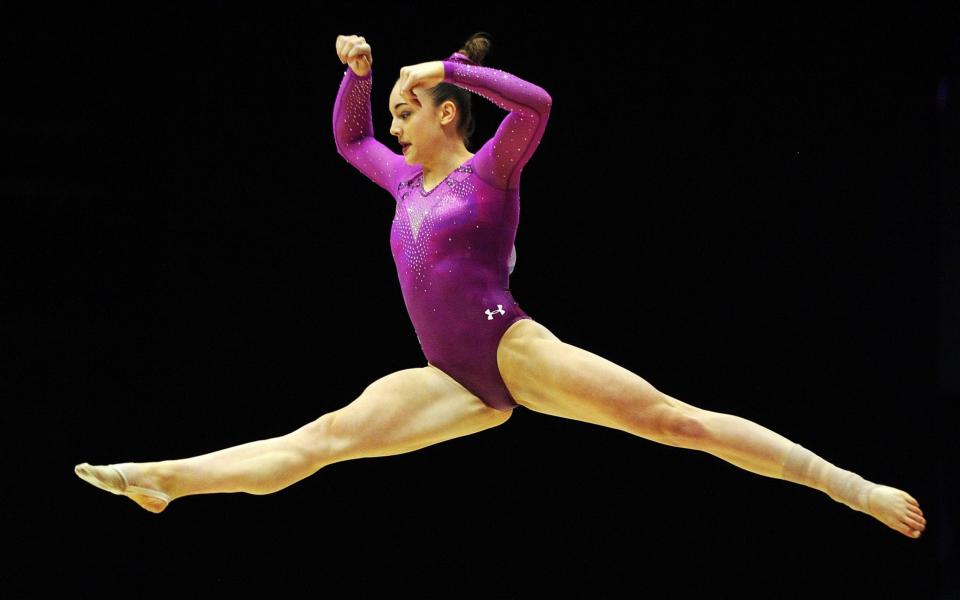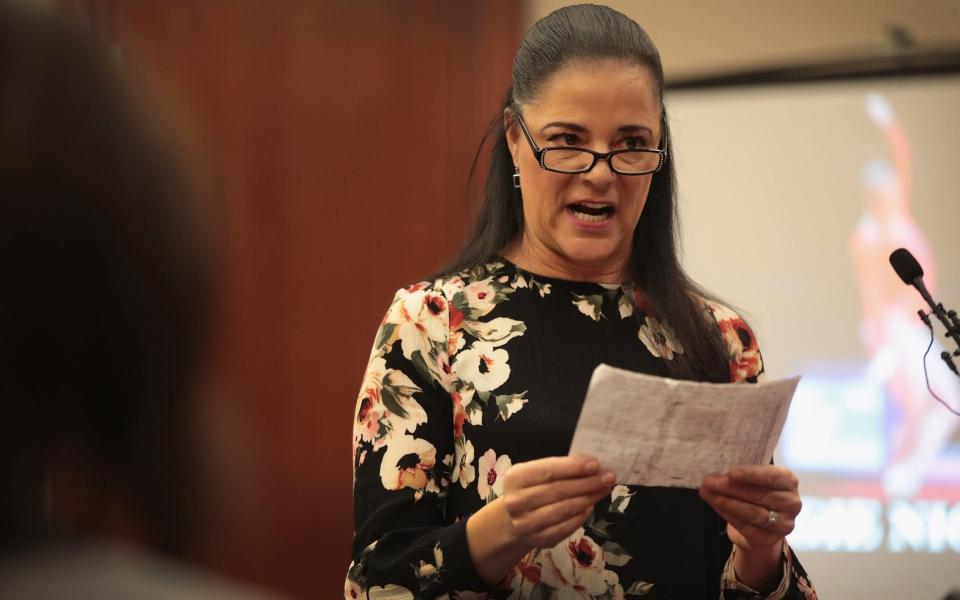'Athlete A' Maggie Nichols on how she brought down Larry Nassar, sport's most evil man

Maggie Nichols was 15 when she noticed a gnawing pain in her back. An elite gymnast for two years, the bulk of her time was spent in the studio practicing somersaults, cartwheels, and balance beams in an attempt to get onto the Team USA Olympic squad - her dream since childhood. But as the sport took its toll on her body, she sought help from the USA Gymnastics national team doctor, a bespectacled, fairly geeky-looking man called Larry Nassar. At a training ranch in Texas, Nassar led Nichols into his office, before closing the door and shutting the curtains - something she thought was “weird, but [I] figured out it must be OK”. Then, she remembers, “he started touching me in places I really didn’t think he should”.
Unsure as to exactly what had happened, Nichols said nothing, even as he continued to assault her on a number of occasions over the next two years. When she eventually reported him in 2015, it sparked a remarkable chain of similar revelations from others that ended with one of the sporting world’s most prolific paedophiles being exposed. At least 265 women and girls have now come forward to accuse Nassar of sexual assault, including Olympian gold medallist Simone Biles, the teen wonder who somersaulted her way into glory at the Rio in 2016.
Nassar, a 56-year-old father-of-three, was sentenced to 175 years in prison in 2018 after pleading guilty to seven counts of sexual assault against minors - only a fraction of the crimes he is accused of committing. When he was arrested, the FBI found 37,000 images of child pornography on his computer.
The story of how Nichols, now 22, helped to hold a man as dangerous as Nassar to account will be told in a widely-publicised Netflix documentary released next week, Athlete A - the title she was given in the press before she waived her right to anonymity two years ago in an emotional open letter.
“I chose to be private and not have my name out there,” she told me over Zoom this week from her bedroom at the University of Oklahoma. “I knew that Athlete A was me and I was proud. [But then I] took a step back and realised that if I came out publicly I could help hundreds, and that’s what I wanted to do.”
“I want everyone to know that he did not do this to Athlete A,” she told the world in her letter, “he did it to Maggie Nichols.”
Nassar’s is not just of a story of one doctor who abused his position, however monstrous he might have been. It is also a story of institutional failure - how the respected osteopath was allowed to go from job to job, abusing children for three decades, despite girls having complained to police about his behaviour as early as the Nineties. And it is one that is sure to raise parallels in this country with the case of Barry Bennell, the ex-football coach convicted of abusing 12 boys over the Eighties and Nineties, when he worked at Manchester City and Crewe Alexandra.
Nichols began gymnastics aged just three while growing up in a tiny Minnesota town, the youngest (and only girl) of four siblings. By 14, she made it onto the US women’s national team, a promotion that brought her into Nassar’s path. He began to send her Facebook messages, telling her how “beautiful” she looked. “I thought he was my friend. I was only 15 and I thought he was just trying to be nice to me.”
The abuse started around the same time. “He didn’t have gloves on, he didn’t explain what he was doing, and there was nobody else in the room,” she says of the multiple times Nassar molested her, always under the pretence of a medical exam. “I accepted what he was doing because I was told by the adults in charge ... that I should receive help from him.”

She had no way of knowing it, but Nassar’s pattern of abuse had actually begun as long ago as 1988. At that point, he was a medical student volunteering at the Great Lakes Gymnastics centre at Michigan State University, according to The Girls, a book about the scandal by Abigail Pesta. His first known victim there was Sara Teristi, a 14-year-old aspiring gymnast, who went public last year. After falling off the uneven bars and dislocating her ribs, her coach shouted, “Go see Larry”. She did, and after a few visits he began fondling her breasts - she believes he was pushing boundaries to see how much he could get away with. The abuse became more serious two years later, when he used Teristi’s tailbone fracture as a pretence to penetrate her anally with his hands. She later mentioned it to a counsellor, but was asked if she was “embellishing”.
Later in the Nineties, the book claims, another girl reported Nassar’s abuse to Michigan police - but was ignored. “Everyone believed the doctor,” Pesta says.
Over the decades, Pesta writes, Nassar did his best to convince everybody that he was “such a nice guy”, distancing himself from other gymnastics coaches who were often tough perfectionists. He befriended the girls and brought them gifts, and in some cases, told their parents that he would not bill them for medical insurance.

But the doctor’s house of cards fell in 2015. After practice one day, Nichols asked a friend whether Nassar ever touched her inappropriately - she says she can’t remember why, on this occasion, she had felt the urge to bring it up. But that conversation would be overheard by their coach, Sarah Jantzi, who helped Nichols report Nassar to USA Gymnastics. The claims were not made public, and Nichols says that gymnasts were lied to about why Nassar - who the group now say had been fired, though this was not made clear at the time - was no longer showing up to practice.
In Start by Believing, authors Dan Murphy and John Barr write that top officials within USA Gymnastics were slow to respond to complaints about Nassar’s conduct. Whilst they did report it to the FBI, they did not warn Michigan State, where Nassar was allowed to continue for months in his full-time job as an osteopath.
Steve Penny, CEO of USA Gymnastics, says that he chose not to tell the university because the FBI had warned him to not to do anything that might impede the investigation. He also says that he did not consider anything he had been told in 2015 to be an “unambiguous claim of sexual assault,” adding that he has been “repulsed” on hearing the full extent of Nassar’s crimes.
Around this time, Nichols was also left off the USA team for the 2016 Rio Olympics, her childhood dream shattered. Her mother, Gina, believes she was ultimately punished for speaking out.
Following an Indianopolis Star investigation in 2016, the claims were made public: in court, dozens of victims lined up to deliver emotional testimony. That of Nichols, then 20, was read by her mother, whose voice cracked as she spoke; the court also heard from Kyle Stephens, a family friend of Nassar who was molested in his basement as a teenager, who told them: “Little girls don’t stay little forever. They grow into strong women that destroy your world.”
Nichols retired from elite gymnastics earlier this year - a decision hastened by the pandemic, which brought an end to this year’s competitions. She plans to “see where life takes” her after graduating from her Communications degree, and tries not to think about Nassar, who will likely die in prison.
“I have good days, I have bad days. But I have a lot of people I can talk to, especially the other girls. I’m still friends with them. That’s something that helps with the healing process.”
The ordeal has, however, left psychological scars. “People who watch gymnastics see young girls fly through the air and do all kinds of amazing things. You can imagine that having a good doctor is absolutely necessary. His job was to care for our health and treat our injuries. Instead, he violated our innocence.”
In a statement to the Telegraph, USA Gymnastics said: “Because of the bravery of Maggie and other survivors who have come forward, there have been transformational reforms across the sport. Within USA Gymnastics, under an entirely new leadership team, we have implemented stronger policies and preventative measures, launched multiple educational efforts, and made sweeping organisational, leadership and personnel changes. Most importantly, we have prioritised changing the sub-culture within our community that allowed this to happen. Despite these changes, we recognize that the work is not yet done. We must keep listening, keep evolving and keep improving – and we are committed to doing so.”
Athlete A is available to watch on Netflix from 24th June
Abigail Pesta's The Girls: An All-American Town, a Predatory Doctor, and the Untold Story of the Gymnasts Who Brought Him Down (Seal Press, 2019) is available to buy for£9.99 online

